

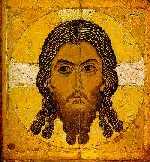
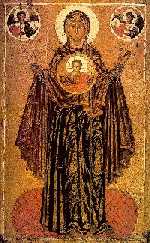
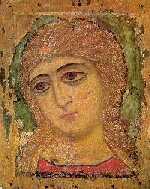
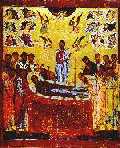
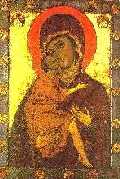
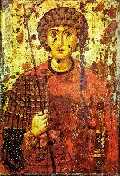
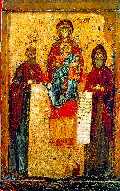
Kiev School icons: First row, from left to right: Christ Acheiropoietos (Made without hands), The Virgin Orans Great Panagia, and The (Arch)angel with the Golden Hair (all 12th c.). Second row, from left to right: The Dormition of the Virgin (end of the 12th-beginning of the 13th c.), The Virgin of White Lake (Belozerskaia) (13th c.), St. George the Warrior (11th-12th c.), The Virgin of the Caves (Pecherskaia), also known as The Virgin of Svena (Svenskaia) (ca. 1288).
You'll find some of these icons attributed to the Novgorodian, Yaroslav, or Rostov-Suzdal School of icon painting. The confusion stems from mixing two approaches, chronological and geographical, in placing the works within a specific school. If one assumes a purely chronological approach, as we do here, then the earliest Russian icons, no matter in what city they were created, should be attributed to the Kievan School. This school was active from the end of the 10th century, the time of Christianization of Russia, until Kiev was sacked and burned by the Mongols in 1240. And even though there might have been some icon painting in Kiev after the fall of of the capital, the center of icon painting moved to the north, to Novgorod.
The first icons were brought to Russia from the Byzantine Empire and from Bulgaria, which became an intermediary between Constantinople and Kiev, supplying the newly Christianized state with books, icons, and liturgical objects necessary for the celebration of the mass. We may suspect that the first painters in Kiev were also Greeks or Byzantinized South Slavs. They became teachers of the first Russian painters and gave them a sound training in the Byzantine style and tradition. Since Russians were always exceedingly adept not only at blind mimicking but at taking a step forward, they quickly learned how to extend the Byzantine style and tradition and make it their own. The early Russian (Kievan) style was still quite dependent on the Byzantine. The compositions were monumental, uncluttered, and simple. Some icons exhibited close affinities with the art of classical antiquity. Most Kievan School icons were painted in darker, more somber tones and were often large in dimensions because they were hand hewn with an axe from a large piece of wood. However, the Russians very quickly abandoned the Byzantine tradition of portraying Christ Pantokrator as a severe and strict judge and started developing a more "humane," understanding, and forgiving image of Christ, the Savior and the Redeemer. This tendency led later, in the Novgorodian and Moscow traditions to the development of a Savior type best known from the work of Andrei Rublev, and to the appearance of the "Russian" variants of many saints, particularly St. Nicholas and St. George. [S.H. and A.B.]
